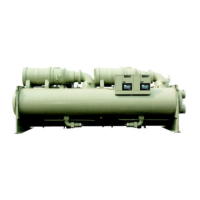74 Product Manual PM WSC/WDC
2. Impeller shall be statically and dynamically balanced. The compressor shall be
vibration tested and not exceed 0.14 IPS.
3. Movable inlet guide vanes actuated by an internal oil pressure driven piston shall
accomplish unloading. Compressors using an unloading system that requires
penetrations of the compressor housing or linkages, or both, that must be lubricated
and adjusted are acceptable provided the manufacturer provides a five-year
inspection agreement consisting of semi-annual inspection, lubrication, and annual
changeout of compressor seals. A statement of inclusion must accompany any
quotations.
4. If compressors are not equipped with guide vanes for each stage and movable
discharge diffusers, then furnish hot gas bypass and select chillers at 5% lower
kW/ton than specified to compensate for bypass inefficiency at low loads.
B. Lubrication System: Each compressor shall have an independent lubrication system to
provide lubrication to all parts requiring oil. Provide a heater in the oil sump to maintain oil at
sufficient temperature to minimize affinity of refrigerant, and a thermostatically controlled
water-cooled oil cooler. Coolers located inside the evaporator or condenser are not
acceptable due to inaccessibility. A positive displacement submerged oil pump shall be
powered through the unit control transformer.
C. Refrigerant Evaporator and Condenser:
1. Evaporator and condenser shall be of the shell-and-tube type, designed,
constructed, tested and stamped according to the requirements of the ASME Code,
Section VIII. Regardless of the operating pressure, the refrigerant side of each
vessel will bear the ASME stamp indicating compliance with the code and indicating
a test pressure of 1.3 times the working pressure but not less than 100 psig. Provide
intermediate tube supports at a maximum of 18 inch spacing.
2. Tubes shall be enhanced for maximum heat transfer, rolled into steel tube sheets and
sealed with Locktite or equal sealer. The tubes shall be individually replaceable and
secured to the intermediate supports without rolling.
3. Provide sufficient isolation valves and condenser volume to hold full refrigerant
charge in the condenser during servicing or provide a separate pumpout system and
storage tank sufficient to hold the charge of the largest unit being furnished.
4. The water sides shall be designed for a minimum of 150 psig or as specified
elsewhere. Vents and drains shall be provided.
5. Chilled water minimum refrigerant temperature shall be 33°F.
6. A self-metering and adjustable thermal expansion valve shall control refrigerant flow
to the evaporator. Fixed orifice devices or float controls with hot gas bypass are not
acceptable because of inefficient control at low load conditions. The liquid line shall
have a moisture indicating sight glass.

